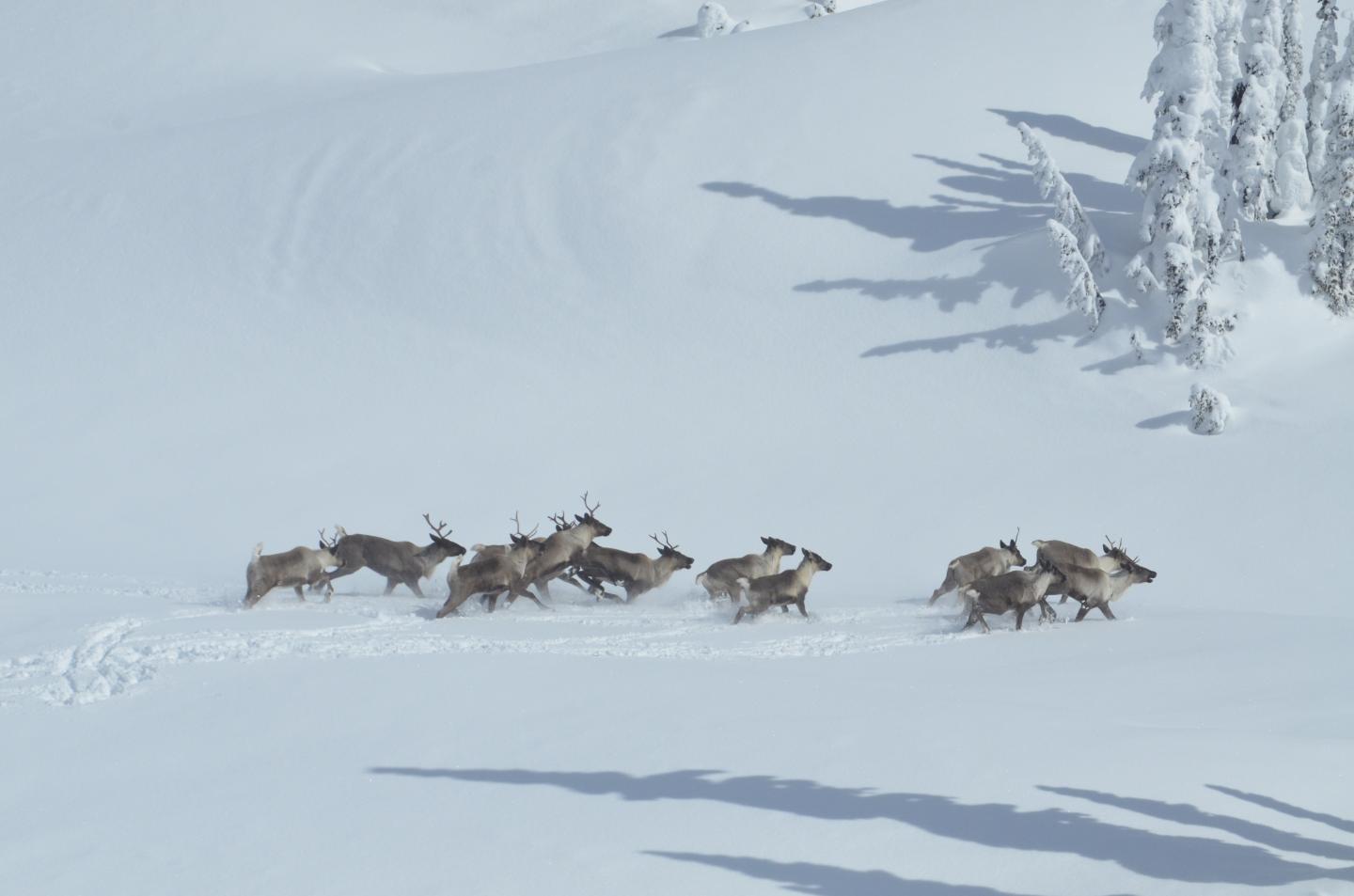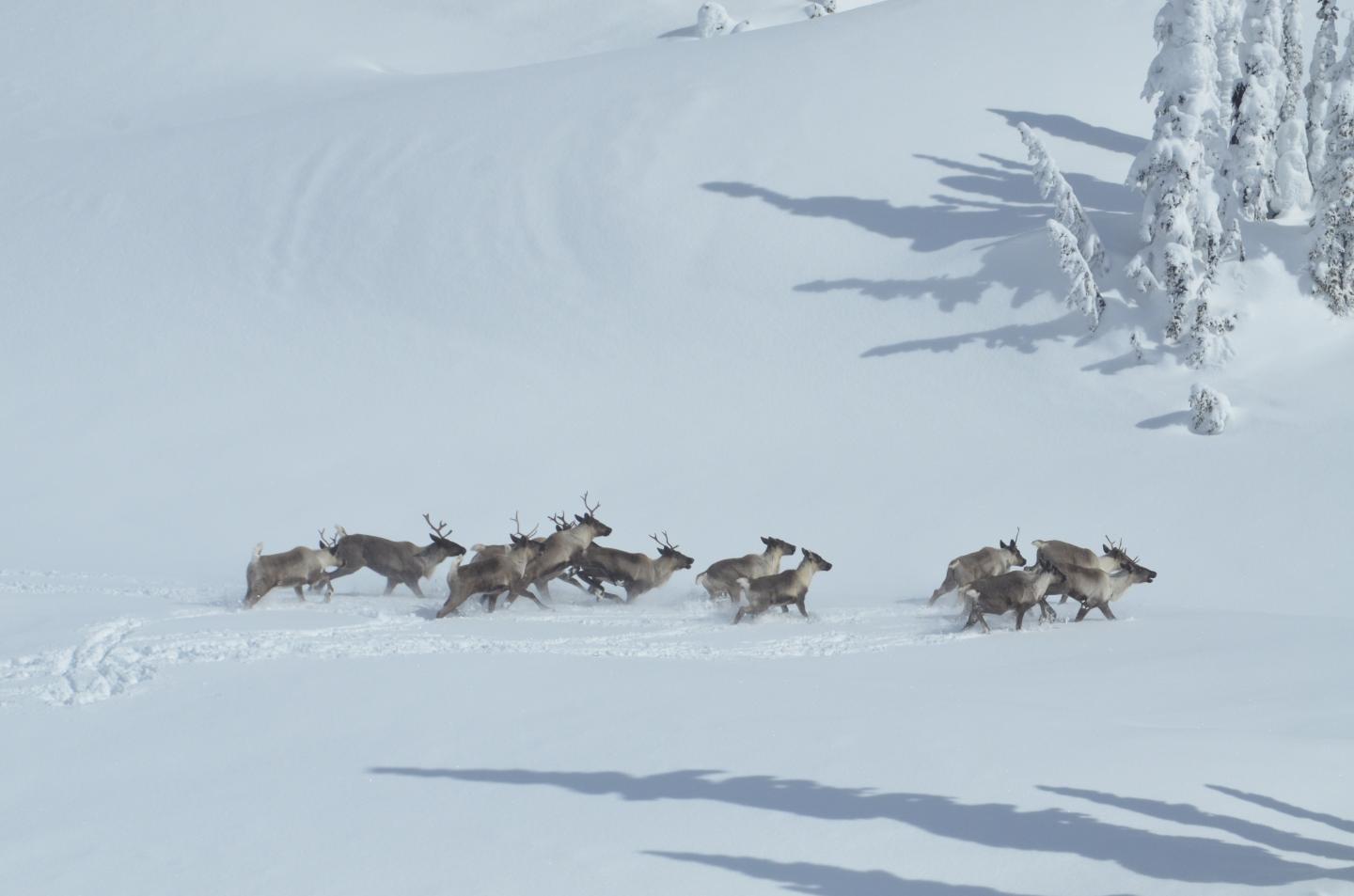
Credit: Robert Serrouya
What happens when invasive and native species are eaten by the same predator? If the invasive species is abundant, the native species can go extinct because predator numbers are propped up by the invading species. This process is called "apparent competition" because on the surface it "appears" that the invading and native prey directly compete with each other, but really the shared predator links the two prey.
Apparent competition is an increasing problem, causing endangerment and extinction of native prey as abundant species colonize new areas in the wake of human-caused change to the environment. This is exactly what is happening to the iconic woodland caribou across North America. Prey like moose and white-tailed deer are expanding in numbers and range because of logging and climate change, which in turn increases predator numbers (e.g. wolves). With all these additional predators on the landscape, more caribou become by-catch, driving some herds to extinction.
A short-term solution would be to kill wolves but this can be seen as just a band aid, and is no longer politically acceptable in many jurisdictions. As a more ultimate solution, Serrouya and colleagues used a new government policy and treated it as an experiment, to maximize learning. The new policy was to reduce moose numbers to levels that existed prior to widescale logging, with an adjacent reference area where moose were not reduced. The results of this research are published in an article titled "Experimental moose reduction lowers wolf density and stops decline of endangered caribou," and is published today in the peer reviewed and open access journal PeerJ.
Following the reduction of moose using sport hunting, wolf number numbers declined, with wolf dispersal rates 2.5 × greater than the reference area, meaning that dispersal was the process leading to fewer wolves. Caribou annual survival increased from 0.78 to 0.88 for the Columbia North herd, located in the moose reduction area, but survival declined in the reference area (Wells Gray). The Columbia North herd probably stabilized as a result of the moose reduction, and has been stable for 14 years (2003 – 2017). By expanding their comparison across western Canada and the lower 48 states, they found that a separate herd subjected to another moose reduction was also stable, whereas at least 15 other herds not subjected to moose reductions are continuing to decline.
The results obtained by Serrouya and colleagues are similar to other studies that used more controversial approaches. For example, in Alberta, 841 wolves were removed in the Little Smoky caribou herd over 7 years, but results were as good or better using the less controversial approach of reducing invasive prey (moose). But, population stability is insufficient to achieve recovery goals for caribou, which require population growth. This conclusion suggests that several limiting factors and management levers must be addressed simultaneously to achieve population growth for caribou. These levers include habitat protection, reducing invading prey, and if needed, short-term and focused predator removal.
###
IMAGES
Image 1: Mountain Caribou in British Columbia, Canada, moving to low elevation during spring. Credit: Hans Mohr (CC BY 4.0)
Image 2: Mountain Caribou in British Columbia, Canada observed during a population census. Credit: Robert Serrouya (CC BY 4.0)
Full Media Pack including image: https://drive.google.com/open?id=0BzGrFBtalE6wZzZUTXBELVY2ek0
EMBARGOED until Aug 29th: 7 am EST; 12 midday UK local time; 11 am GMT (i.e. the date of publication)
PDF of this Press Release: http://static.peerj.com/pressReleases/2017/08/Press-Release-Serrouya.pdf
Link to the Published Version of the article (quote this link in your story – the link will ONLY work after the embargo lifts): https://peerj.com/articles/3736 your readers will be able to freely access this article at this URL.
Citation to the article: Serrouya et al. (2017), Experimental moose reduction lowers wolf density and stops decline of endangered caribou. DOI 10.7717/peerj.3736
About:
PeerJ is an Open Access publisher of two peer-reviewed journals and a preprint server. PeerJ is based in San Diego, CA and the UK and can be accessed at https://peerj.com/. PeerJ's mission is to help the world efficiently publish its knowledge.
All works published in PeerJ are Open Access and published using a Creative Commons license (CC-BY 4.0). Everything is immediately available–to read, download, redistribute, include in databases and otherwise use–without cost to anyone, anywhere, subject only to the condition that the original authors and source are properly attributed.
PeerJ has an Editorial Board of over 1,600 respected academics, including 5 Nobel Laureates. PeerJ was the recipient of the 2013 ALPSP Award for Publishing Innovation. PeerJ Media Resources (including logos) can be found at: https://peerj.com/about/press/
Media Contacts
For the authors:
Dr Robert Serrouya
Phone: (250) 837-7767
Cell: (250) 814-4632
[email protected]
For PeerJ: email: [email protected] , https://peerj.com/about/press/
Note: If you would like to join the PeerJ Press Release list, please register at: http://bit.ly/PressList
Media Contact
Dr. Robert Serrouya
[email protected]
250-837-7767
@ThePeerJ
http://https://peerj.com
Related Journal Article
http://dx.doi.org/10.7717/peerj.3736





